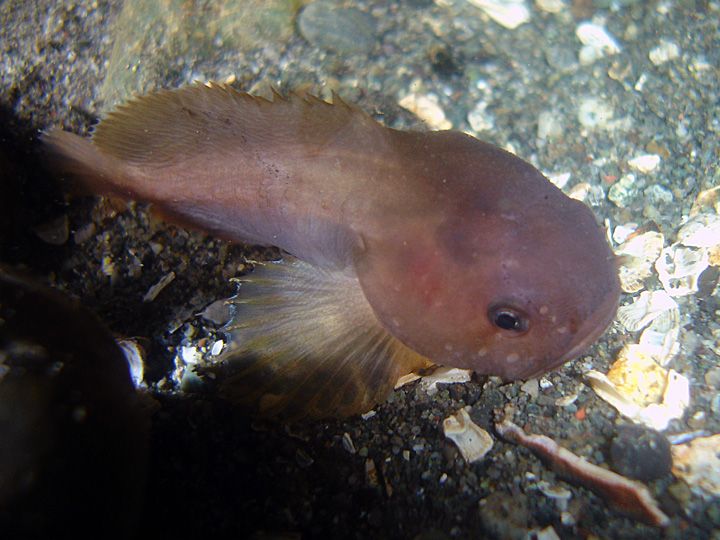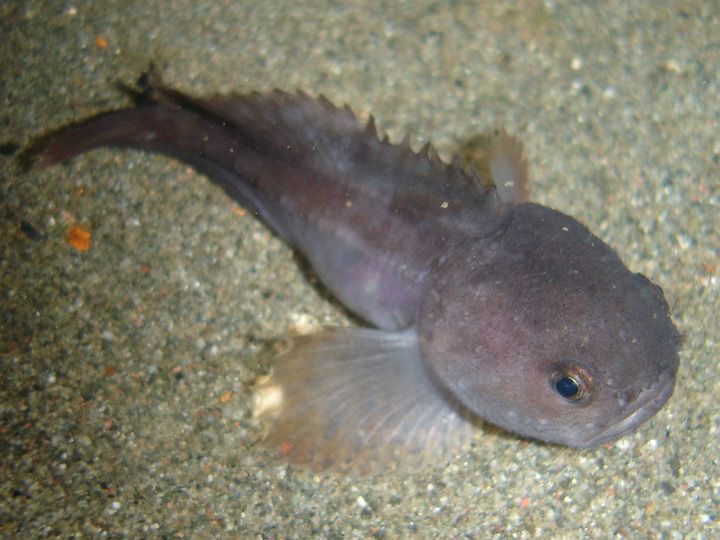
Psychrolutes sigalutes
FAMILY
Psychrolutidae
TAXONOMY
Psychrolutes sigalutes Jordan and Starks, 1895, Puget Sound near
Port Orchard, Washington, United States. Species is listed as
Gilbertidia sigalutes in older species compendiums, and is listed
as a member of the
FAMILY
Cottidae.
OTHER COMMON NAMES
None known.
PHYSICAL CHARACTERISTICS
The soft sculpin has flaccid skin in which the single dorsal fin
seems embedded. The lateral line and head canal pores of
adults are large and obvious, especially around the jaws and
cheeks. Adults are dark brown or translucent beige. Adult
males are much larger than females and often have scars over
their large heads. Males can approach 3.5 in (9 cm) in length.
The pelagic young have relatively larger eyes, no obvious
pores, and are purple with orange pectoral fins.
DISTRIBUTION
Coastal waters from Puget Sound, Washington, to the Aleutian
Islands, Alaska.
HABITAT
Larvae of the soft sculpin migrate to feed at the surface at
dawn and dusk. Then as pelagic juveniles, they alternate between
settling to soft bottom and migrating to the surface on
dark nights when surface plankton is abundant. Females grow
to 75% of mature body size while exploiting the plankton. Soft
sculpins permanently settle during late spring and occupy deep
crevices or recesses in multilayered rock rubble, usually on
shorelines protected from wave surge.
BEHAVIOR
The male soft sculpin continues growing after settlement,
whereas the female starts developing ripe ovaries. The male is
highly territorial, rotating his body in a circle and stuttering
his head to keep other males away from his territory. Head biting
occurs among males.
FEEDING ECOLOGY AND DIET
Feeding is visual during early larval stages, then the pelagic juveniles
switch to use of distant touch at night as the eyes become
relatively smaller and the head canal pores enlarge.
Adults in crevices use distant touch to detect crustacean prey
like amphipods. Adults cannibalize young soft sculpins that enter
their territory.
REPRODUCTIVE BIOLOGY
The male soft sculpin attracts a harem of several females and
courts them in synchrony prior to copulating with each female
in sequence. Females simultaneously lay a group, monolayer
egg mass on the underside of a rock surface. The females tend
the eggs communally, the fanning
BEHAVIOR
of one female stimulating
similar
BEHAVIOR
in adjacent females. The male remains
to one side and guards the nest site against other fishes or invertebrates.
At hatching, the females suck larvae from the egg
shells, swim away from the nest crevice, and spit the larvae toward
the surface.
CONSERVATION STATUS
Not listed by the IUCN. Detection of soft sculpins tends to
occur rarely. It is doubtful whether human activities directly
affect this species.
SIGNIFICANCE TO HUMANS
None known.
Photo Gallery of - Soft sculpin





 Animalia Life
Animalia Life